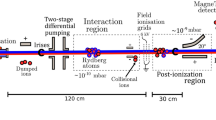Abstract
Recently, intense beams of highly charged ions have become available at heavy ion cooler rings. The obstacle for producing these highly interesting candidates is the large binding energy of K-shell electrons in heavy systems in excess of 100 keV. One way to remove these electrons is to strip them off by passing the ion through material. In the cooler ring, the ions are cooled to a well defined velocity. At the SIS/ESR complex it is possible to produce, store, and cool highly charged ions up to bare uranium with intensities exceeding 108 atoms in the ring. This opens the door for precision laser spectroscopy of hydrogenlike-heavy ions, e.g.209Bi82+, and allows to examine the interaction of the single electron with the large fields of the heavy nucleus, exceeding any artificially produced electric and magnetic fields by orders of magnitude. In the electron cooler the interaction of electrons and highly charged ions otherwise only present in the hottest plasmas can be studied.
Similar content being viewed by others
References
L. A. Rivlin, Sov. J. Qu. E. 9 (1979) 359.
R. Neumann et al., Z. Phys. A313 (1983) 253.
U. Schramm, J. Berger, M. Grieser, D. Habs, E. Jaeschke, G. Kilgus, D. Schwalm, A. Wolf, R. Neumann and R. Schuch, Phys. Rev. Lett. 67 (1991) 22.
H. Poth, Phys. Rep. 196 (1990) 135.
G. Zwicknagel et al., these proceedings, Hyp. Int. 99 (1996) 285.
B. Franzke, Nucl. Instr. Meth. B24 (1987) 18.
S. Borneis et al., Phys. Rev. Lett. 72 (1994) 207.
S. Borneis et al., Contr. RIS94, Bernkastel (1994), eds. H.-J. Kluge et al., AIP Woodbury, p. 150.
T. Kühl, Phys. Scr. T22 (1988) 144.
M. Finkbeiner, B. Fricke and T. Kühl, Phys. Lett. A176 (1993) 113.
S.M. Schneider, J. Schaffner, W. Greiner and G. Soff, J. Phys. B26 (1993) L581.
I. Klaft et al., Phys. Rev. Lett. 73 (1994) 2425.
M. Tomaselli, D. Herold and L. Gruenbaum, Nuovo Cimento 46 (1978) 1431.
M. Tomaselli, S.M. Schneider, E. Kankeleit and T. Kühl, Phys. Rev. C51 (1995) 2989.
A. Rüetschi, L. Schellenberg, T.Q. Phan, G. Piller, L.A. Schaller and H. Schneuwly, Nucl. Phys. A422 (1984) 461.
S.M. Schneider, W. Greiner and G. Soff, Phys. Rev. A50 (1994) 118.
H. Persson, I. Lindgren and S. Salomonson, Phys. Scr. T46 (1993) 125.
S.M. Schneider, H. Persson and G. Soff,Proc. EAS, eds. Düsterhöft et al., Kassel (1995).
L.N. Labzowski et al., Phys. Rev. A51 (1995) 4597;
I. Bednyakov et al., to be published.
A. Schneider and H. Stöcker, private communications.
U. Schramm et al., Phys. Rev. Lett. 75 (1995) 802;
Th. Schüssler et al.,1st Euroconf. on Atomic Physics with Stored Highly Charged Ions, Heidelberg, Germany (1995).
Author information
Authors and Affiliations
Rights and permissions
About this article
Cite this article
Kühl, T., Borneis, S., Becker, S. et al. Precision laser spectroscopy of highly charged ions. Hyperfine Interact 99, 145–153 (1996). https://doi.org/10.1007/BF02274918
Issue Date:
DOI: https://doi.org/10.1007/BF02274918




